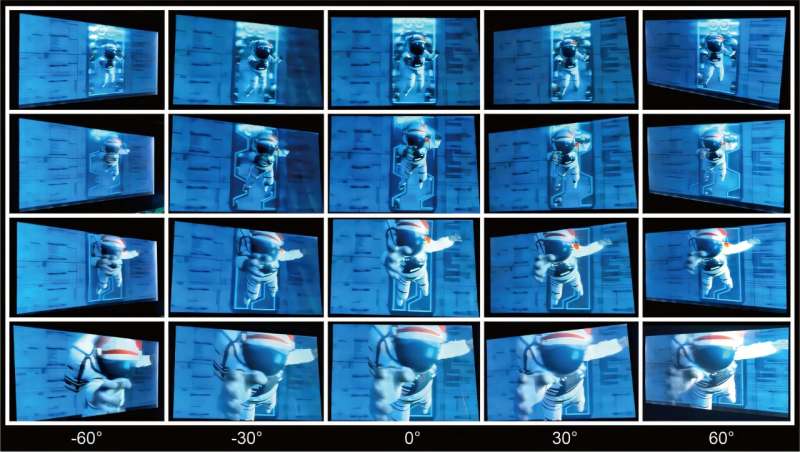Researchers have developed an ultra-thin 3D display with a wide viewing angle, clear image quality and vivid display depth. By overcoming tradeoffs that typically limit glasses-free 3D displays, the advance could open new possibilities for highly detailed interactive experiences in health care, education and entertainment.
“The new display is just 28 mm thick, dramatically slimmer than conventional directional backlight systems, which typically exceed 500 mm,” said research team leader Xu Liu, from Zhejiang University in China. “This level of compactness, combined with the substantial boost in resolution we achieved, represents an important step toward making the technology practical for real-world products.”
In Optica, the researchers demonstrate an ultra-slim 32-inch directional backlight-based prototype based on the new display design. The prototype is roughly the size of a large computer monitor, has a wide viewing angle of over 120° and a large 3D display volume of 28 × 16 × 39 inches.
“The 3D display maintains crisp image quality across the entire imaging depth, which can help users visualize depth and spatial relationships for tasks requiring precise spatial understanding,” said Rengmao Wu from Zhejiang University, corresponding author of the paper. “This could, for example, help doctors easily see complex anatomical structures such as tumors or fractures in real time.”
Seeing 3D without glasses
3D light field displays create a scene by using a directional backlight to direct light in a highly controlled manner. This design allows each eye to see a slightly different image, creating a natural sense of depth without requiring the viewer to wear 3D glasses. The quality of the rendered 3D effect depends on how accurately the voxels—the 3D pixels that make up the image—are constructed, as well as on their number and size, since smaller, well-constructed voxels enable finer detail and more realistic depth.
“In light field displays employing diffraction gratings or cylindrical lens arrays, voxel size is fundamentally constrained by the angular spread of backlight illumination,” said Xinzhu Sang from Beijing University of Posts and Telecommunications in China, who made key contributions to the work. “Our system significantly improves voxel construction accuracy compared to existing scattering backlight-based 3D displays, achieving highly miniaturized voxels and substantial resolution enhancement.”
Freeform optics—advanced optical elements that use freeform surfaces to precisely control light—provided the design flexibility needed to create the ultra-slim yet expansive directional backlight system. Each beam-shaping channel of the display integrates an LED source, an aperture and a freeform lens that precisely redirects incident light to generate uniform illumination with precise directionality. The researchers tiled these beam-shaping channels to create a tailored large-area directional backlight system. The display also uses a module consisting of two layers of micro-triangular prisms to significantly improve backlight irradiance uniformity while preserving the directionality.

Clear gains over conventional displays
After making a 32-inch prototype based on the new design, the researchers evaluated its performance using a 50-mm fixed-focus lens with an f/2.8 aperture, a setup often used to simulate how the human eye perceives depth and clarity.
In one experiment, they used the ultra-thin 3D light-field display to render images of an astronaut floating outside a space station. The display exhibited a continuous depth range of 1 m and a viewing angle of more than 120°, providing an immersive and realistic visual experience.
They also compared the new design with conventional scattering backlight displays, finding that it produced six times smaller voxels and maintained resolution even when viewed from farther away. The display was also about 100-fold more efficient at using visual information to generate images than scattering backlight displays.
The researchers are now working to further reduce the thickness and weight of the device while improving its optical efficiency. For commercialization, they point out that more work is needed to develop smaller pixel structures, increase pixel density and optimize pixel shape to enhance compatibility with 3D display technology.
More information:
Zijun Zhang et al, Miniaturized-voxel light field panel displaybased on an ultra-slim and large-area freeform directional backlight, Optica (2025). DOI: 10.1364/optica.571647
Citation:
Ultra-thin 3D display delivers wide-angle, highly-detailed images (2025, November 5)
retrieved 5 November 2025
from https://techxplore.com/news/2025-11-ultra-thin-3d-display-wide.html
This document is subject to copyright. Apart from any fair dealing for the purpose of private study or research, no
part may be reproduced without the written permission. The content is provided for information purposes only.

